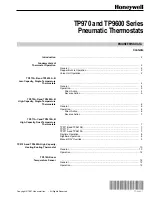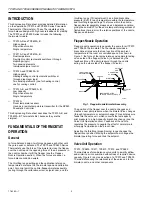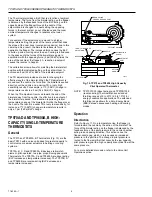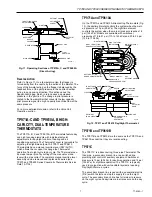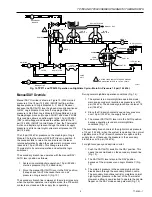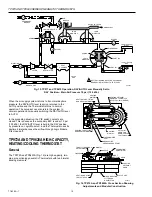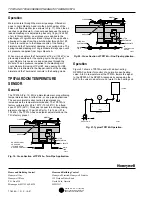
TP790 AND TP9600 SERIES PNEUMATIC THERMOSTATS
3
77-9382—1
Fig. 2. Cross Section of TP970 and TP9600 Thermostat Showing Valve Unit and Airflow.
Figure 4 shows the valve unit supplying air to the branch
line. This condition occurs when the bimetal sensing element
forces the Thermostat flapper toward the nozzle, decreasing
the nozzle-flapper gap and increasing the pilot pressure.
The increased pilot pressure against the pilot diaphragm
overcomes the force of the BLP on the branchline
diaphragm. This change opens the valve unit at Point B,
allowing main air to flow into the branch line. BLP builds until
the pressure against the branch diaphragm again equals the
pressure against the pilot chamber diaphragm. The main
airflow then shuts off, bringing the valve unit into a balanced
condition at a new pressure.
With direct-acting bimetal sensors, a temperature increase
closes the nozzle-flapper gap; with reverse-acting bimetal
sensors, a temperature increase opens the nozzle-flapper
gap. The arrows in the air passages in Figure 4 show the
direction of airflow.
C6047-1
FLAPPER
BIMETAL
FILTER
RESTRICTOR
BRANCH LINE
THROTTLING RANGE
ADJUSTMENT
CALIBRATION
SCREW
SETPOINT
CAM
SETPOINT
KNOB
NOZZLE
BRANCHLINE
PRESSURE TAP
BRANCHLINE
CHAMBER
BLEED
PILOT
PILOT
CHAMBER
EXHAUST
VALVE
MAIN
LINE
TP970, TP9600, TP971, TP9610, TP972, and TP9620
Thermostats are designed around a valve unit for flow
amplification rather than conventional pressure amplification.
Branchline chamber and pilot chamber design are such that
branch pressure is equal to nozzle pressure at a higher
capacity.
Figures 3, 4, and 5 are cross-sections of the valve unit only,
showing air passages and the pilot-branch diaphragm
relationship.
Figure 3 shows a valve unit in a strategic or balanced
condition. All the forces are equal; BLP equals the pilot-line
pressure.
No main air enters the branchline chamber and no exhaust
air leaves the branchline chamber. In this static condition,
the valve is sealed at both Points A and B, preventing airflow.
Fig. 3. Valve Unit Flow Amplifier in a
Balanced (Static) Condition.
PILOT CHAMBER
EXHAUST
BRANCH
CHAMBER
POINT A
POINT B
MAIN LINE
BRANCH
LINE
VALVE
PILOT AIR
C6048-1
Fig. 4. Valve Unit Shown with Pilot
Chamber Pressure Increased.
POINT A
EXHAUST AIR
POINT B
MAIN LINE
BRANCH
LINE
PILOT AIR
C6049-1
NOTE: THE SEAL AT POINT A DOES NOT
ALLOW AIR TO EXHAUST.
VALVE

